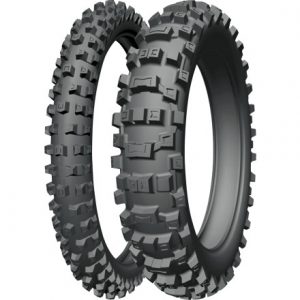Introduction to the AC10 Dual Sport Tire
Among the array of dual-sport tires available, the AC10 stands out, pushing the boundaries of aggressiveness. For those not in the know, the AC10 is no ordinary tire; it’s crafted for specific adventurers. Through our rigorous testing on a DR-Z400, we’ve gained insights into the capabilities of this tire and who it’s truly made for.
Target Audience: The Dirt Bike Enthusiasts
At its core, the AC10 is envisioned for dirt bike riders. These riders predominantly chart their paths on rough terrains but occasionally crave the thrill of the open road. The design and aesthetics of the tire offer an immediate hint of its fierce nature, further corroborated by the limited sizes it’s available in.
As of now, potential buyers can only opt for an 8121 front and two distinct 18-inch rear tire sizes.
A Gritty Expedition: Testing in the Nevada Desert
Testing tires requires more than just a few spins around the block. To genuinely gauge the AC10’s resilience and performance, we embarked on a challenging 1,200-mile odyssey through the diverse terrains of the Nevada desert road. Our journey exposed the tire to a spectrum of conditions, from the tranquility of slow-paced rides to the adrenaline rush of high-speed chases.
Performance Analysis: Where the AC10 Shines
Our expedition revealed the AC10’s strengths and limitations. The tire showcased exemplary performance in slower terrains, particularly when navigating through mud and soft dirt. Surprisingly, it also held its own during high-speed stretches, delivering a ride that was both thrilling and secure. However, a slight hiccup was observed with the front tire. Given its narrower design, the front end felt a tad unstable when pushed to its limits on high-speed dirt roads. This observation hints that the front tire might not be tailor-made for extreme speeds.
Exploring the Michelin AC10’s Rear Tire Performance
Off-road biking enthusiasts are constantly in search of the ideal tire that offers both performance and durability. Michelin, a renowned name in the tire industry, has introduced the AC10, catering specifically to the unique demands of off-road terrains. Here, we delve into the details of the AC10’s rear tire, examining its wear and overall performance after an intensive 1,200-mile test run.
Initial Impressions and Wear Analysis
The journey began with a rear tire featuring a 16-millimeter knob. As the expedition progressed, it was evident that the tire was wearing down, albeit at a consistent pace. By the end of the 1,200 miles, approximately 8 millimeters of the knob remained intact. A simple projection from this wear pattern indicates that the AC10 rear tire’s lifespan hovers around the 2,000-mile mark. Given its design as an off-road knobby tire, such wear rates are within expected limits.
The Role of the Rubber Compound
Michelin has opted for a softer rubber compound for the AC10’s rear tire. This choice is typical for off-road tires, mainly due to the advantages it offers in terms of grip and adaptability. The softer compound ensures that the tire can firmly grip uneven terrains, especially rocky surfaces, enhancing the bike’s overall stability and control. Additionally, a significant observation from our testing was the tire’s ability to resist “chunking”. Despite the prolonged use, the knobs on the tire remained intact, with no signs of cracking or breaking off.
Performance Versus Durability
The softer rubber compound, while excellent for performance and adaptability, comes with a trade-off in terms of durability.
While the AC10 rear tire offers commendable performance, it does wear down at a slightly accelerated rate. However, for many off-road biking enthusiasts, the enhanced performance might justify the quicker wear.
Ultimately, choosing a tire boils down to individual preferences and priorities. Whether you prioritize performance or durability, it’s essential to make an informed decision, keeping your biking habits and requirements in mind.
Michelin’s Innovative Approach to Tire Design
In the realm of motorbike tires, Michelin has been a pioneering name, renowned for its innovative designs and advanced technology. One of the standout features that the brand has introduced in its latest line-up is a unique design twist for both the front and rear tire.
Contrary to most conventional designs, Michelin’s latest offering comes with a non-directional pattern, which means that these tires can run in either direction.
The Utility of a Non-Directional Design
Now, one might wonder, why opt for a non-directional tire? The reason behind this innovative approach is both practical and aimed at enhancing the tire’s longevity. As tires wear down with use, their performance tends to deteriorate, especially when it comes to grip on challenging terrains. With the non-directional design, once a tire starts showing significant wear, it can be easily removed, flipped, and remounted in the opposite direction. This allows users to leverage the sharper, less worn edge on the other side of the tire, effectively rejuvenating its grip and performance on the road.
Performance Expectations
Given the innovative design approach and the renowned quality assurance that comes with the Michelin brand, it is anticipated that this tire will exhibit commendable performance off-road. By allowing users the flexibility to switch tire directions, Michelin ensures that bikers can continue to experience optimal grip and control even after extended use. It’s not just a design tweak; it’s a strategic enhancement aimed at prolonging tire life and ensuring sustained performance.
For bikers who often find themselves venturing off the beaten path and exploring challenging terrains, such a feature can prove to be a game-changer. It signifies Michelin’s commitment to delivering products that don’t just meet but exceed the expectations of their user base.
Conclusion: Michelin’s Forward-Thinking in Tire Design
Michelin’s non-directional tire design is a testament to their dedication to innovation and user-centric solutions. By allowing riders to flip and reuse the tire, they’ve effectively extended its lifespan and ensured a consistent performance throughout. This design not only highlights Michelin’s prowess in understanding the needs of bikers but also their commitment to sustainability and resource optimization. Riders can now enjoy prolonged tire life without compromising on grip or control. It’s clear that Michelin continues to lead the way, setting benchmarks for other brands to follow. Their latest offering reaffirms their position as pioneers in the motorbike tire industry.




